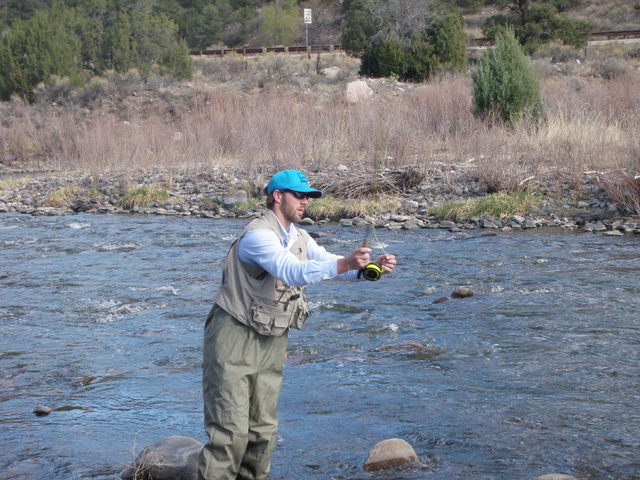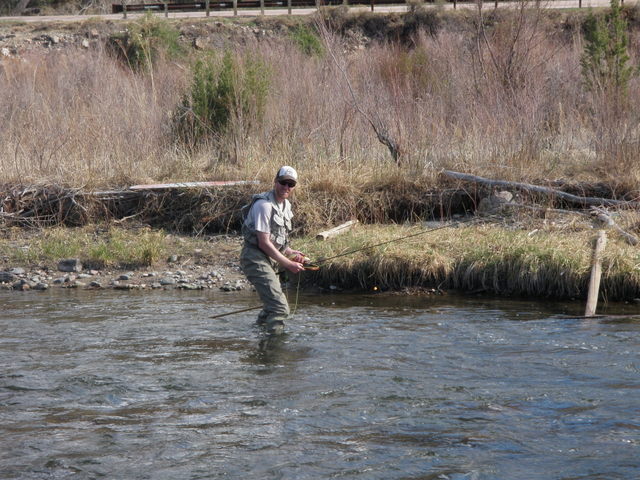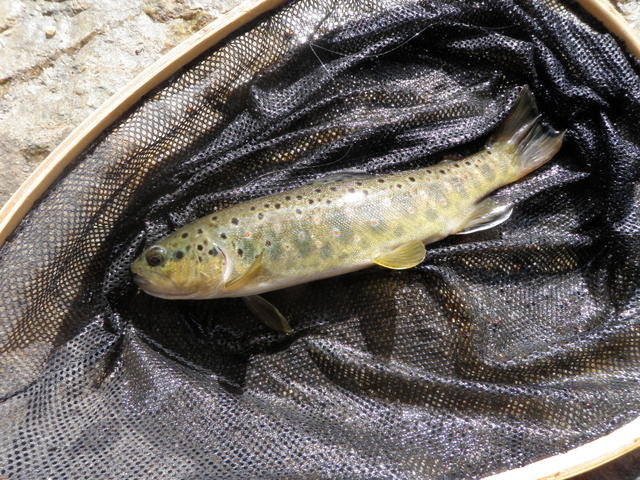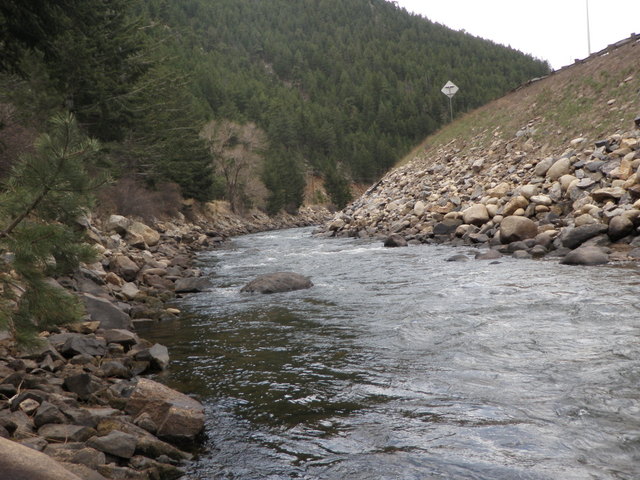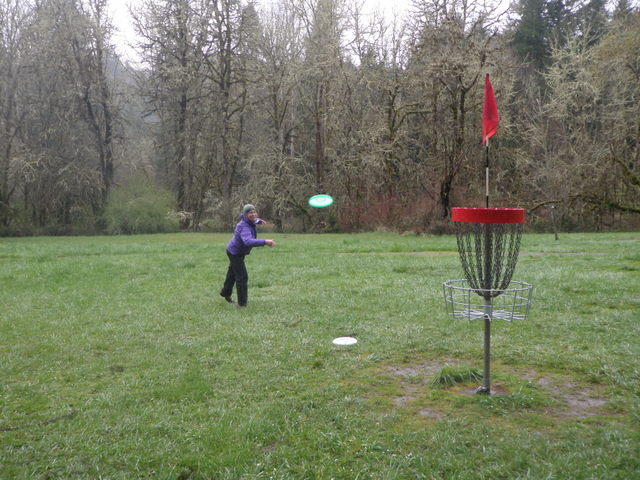Time: 9:30AM – 4:00PM
Location: Fremont – Chafee County Line
Fish Landed: 22
Arkansas River 04/24/2012 Photo Album
Awesome and epic are probably two of the more overused adjectives in the modern English vernacular so I won’t use them to describe my day of fishing on Tuesday, April 24. Instead I’ll settle for spectacular, and this adjective was achieved even though I did not manage to find the sweet spot of the caddis emergence and had to overcome two significant hardships.
Dan and roommate Adam and I spent Saturday on the Arkansas River on the lower water near Salt Lick, and it was obvious we were below the emergence area. When this is the case, the caddis are everywhere but on the water until egg laying commences and this coincides with waning daylight. Saturday was a warm clear day and the egg laying activity probably occurred in the evening after we departed. I studied the stream reports on Royal Gorge Anglers web site as well as ArkAnglers in Salida, and as near as I could tell, the hatch had progressed to Cotopaxi by Saturday. With high temperatures forecast for the 80’s for Sunday, Monday and Tuesday I felt the caddis would advance rapidly, and my only shot at meeting the front edge would be to return to the Salida area on Tuesday. I also decided to get an early start so I could be on the water in the morning before air temperatures and water temperatures soared.
I had everything prepared on Monday night and that enabled me to depart the house at just after 6AM and beat the morning commuter traffic around Denver resulting in arrival at the Fremont – Chafee County line below Salida by 9AM. There were quite a few campers at the area just east of Salida, so I felt I was on the right track. Fortunately because it was a weekday, this did not translate to a lot of fishermen on the water during most of the day. I quickly jumped into my waders, strung my rod and negotiated the path down the steep bank and crossed at the tail of the large pool next to the pullout. I climbed the bank on the north side of the river and hiked down the railroad tracks to my favorite starting point below the small island.

First Trout on Tuesday Morning
It was actually cool enough that I wore a fleece and was comfortable for the first hour of fishing as I rigged up my four piece Sage four weight rod with a thingamabobber, Arkansas rubber legs and a beadhead RS2. I began flinging the weighted nymph into the nice deep run at the tail and working my way methodically upstream to the island and within fifteen minutes I’d landed a nice 14-15 inch rainbow that snatched the RS2. The Arkansas rubber legs didn’t seem to be producing after I’d covered the water up to the bottom of the island and it was causing my flies to hang up frequently so I clipped it off and replaced with a beadhead bright green caddis pupa. At the very top of the run, my indicator paused and I set the hook and landed a nice feisty brown on the bright green caddis pupa. My outlook was pretty positive after catching fish on both a caddis pupa and RS2 which imitates a blue wing olive nymph.
I was very anxious to fish the right channel on the north side of the island as this has historically produced my best fishing on the entire Arkansas River system, but because the water is lower and not as fast, the indicator/nymph approach did not seem appropriate. I decided to fish up along the left side of the island with my tandem nymph approach and return to the bottom of the north channel and change my set up. It was a great decision as I landed another nice brown on the RS2 and then at the very head of the run near the top of the island, I hooked another rainbow. This fish was a tough opponent and it ran into the heavy current, and I worked it back and forth several times. Finally I worked the fourteen inch rainbow to within a couple feet of my legs, but when I pulled out my net, the fish spooked and shot out in the current again. It ran downstream a bit and then stopped, and as I applied side pressure to bring it back to me, the tip on my rod snapped. The exhiliration of landing a fine rainbow was surpassed by the sinking knowledge that I’d just snapped the tip on my favorite rod.

My Favorite Stretch of Arkansas River
After I grieved a bit, I picked up the broken tip and hustled back to the car and procured my Loomis two piece five weight. I’d been fishing for 45 minutes and landed four nice fish, but now I spent 20-30 minutes hiking back on the railroad tracks, crossing the river, removing my fleece, stowing the broken rod and setting up the backup rod. When I returned to the bottom of the island I had no flies on my new rod, so I could begin with a fresh approach. I elected to go dry/dropper with a size 12 bushy caddis/stimulator with a light olive body as my top fly and the beadhead RS2 on a 2.5 foot dropper. I worked up the full length of the north channel with this combination and landed six beautiful browns on the RS2. I began to see some BWO’s sporadically on the water, so the fish must have been tuned into the nymphs. I experienced numerous refusals to the stimulator as well and also quite a few momentary hookups. The action was fast and furious, but particularly strong in the large main pool near the bottom of the channel.

Length of the Net Bruiser
When I reached the top of the island it was close to noon and lunch time so I debated adjourning to the car, but decided to continue through the nice riffles and pockets along the north bank between the island and my crossing point. I managed to land two more fine Arkansas browns in this area on the RS2. Again I witnessed some refusals and several momentary hook pricks before I reached the tail of the large pool and waded back to the south bank for lunch at 12:45. I was feeling pretty euphoric with twelve fish landed in spite a losing 30 minutes during prime time and breaking the tip of my favorite rod.
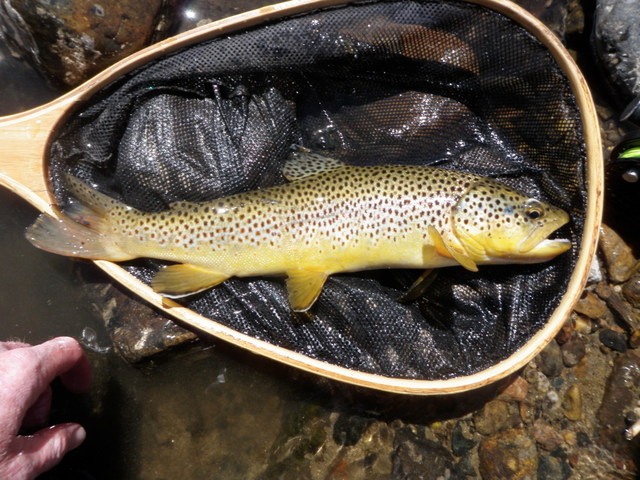
Another Gorgeous Speciman
As is my custom I grabbed my lunch and water bottle from the car and walked down to a large ledge rock next to the large pool below the Santa Fe. I was perched eight feet above the river, and as I ate I observed a nice rainbow cruising the pool upstream from my lunch seat by ten feet or so. The fish cruised about in an oval path and every once in a while slowly moved to the surface and slowly sipped. Since I planned to clip off my flies and go back to the indicator/split shot method after lunch, I decided to try for the rainbow before going that route. I fetched my rod from the car and positioned myself upstream from the large rock but stood 5-8 feet back from the water. I tied on a CDC BWO and tried to place some casts at the top of the cruise area. The wind had picked up and each of the first five casts were way off target. The line was shooting straight out from me toward the desired target, but the cross wind knocked the fly back downstream beyond the large rock.
Finally I executed a low cast that was almost a roll cast. I couldn’t see the rainbow anymore and began to despair that I’d put it down. But as I watched the water I saw the fish appear two thirds of the way from the top to the edge of the rock and sip something on the surface. I estimated my fly might be the morsel sipped by the rainbow and I set the hook and felt the weight of the fish. I applied side pressure to prevent it from heading downstream and eventually brought it to my net. It was a beauty and larger than it appeared from my lunch perch.

Spotted During Lunch
Seeing no more rising fish, I gathered my line and crossed the river again at the tail of the long pool and walked part way down the tracks to a point at the base of the nice wide riffle section that I’d covered in the late morning. I tied on a beadhead bright green caddis pupa and below that added the RS2 and fished these two flies wet fly style with a split shot and indicator. Between 1:15 and 2:30 I picked up another four fish and three fell for the caddis pupa and one for the RS2. Most of these fish hit as the flies did a swing through water that was 3-4 feet deep and flowing at a moderate pace. These fish continued to be fine chunky browns in the 12-13 inch range.
By 2:30 I moved up into the right side of the long pool across from the Santa Fe. I was going to skip this water and move to the faster moving run that feeds the pool but as I worked my way up along the bank I spotted a couple rises. I paused and watched the water as some large clouds moved in from the west and blocked the sun and reduced the light intensity. The wind continued to gust relentlessly and the pool came alive with five or six fish rising with increased regularity. Should I go to the trouble of clipping off my wet flies and tie on a dry fly? I began swinging my wets above positions where I’d seen rises, but this had no impact so I relented and changed to a size 14 deer hair caddis with a dark olive body.
Initially I witnessed a few refusals and mentally was cursing my choice of a size 14, but I began to see more caddis tumbling on the water and made a downstream cast so it floated on a lane where a fish had risen. Smash! A brown aggressively hammered my fly and I had my first catch on a dry fly of the day. There were some fish rising no more that 5-10 feet above me and within 10 feet of the bank, but I was trying to execute a backhand cast into the wind and it wasn’t effective. I decided to wade out five feet in the deep pool so I was waist deep but away from the tall vegetation and able to make a backcast over the river. Having negotiated this repositioning, I shot a couple casts to the area where I’d seen a fish rise a couple times, but nothing was doing. But as I was about to turn and look elsewhere I spotted a rise within two feet of the bank five feet above me. I looped a cast so the fly came down in a curve to the right of my line and as the caddis drifted to the spot of the rise, and trout emerged and engulfed my fly. The fight was on and I managed to land a beefy brightly colored brown that extended beyond the length of my net. This was the fish of the day and the fish of my season so far.
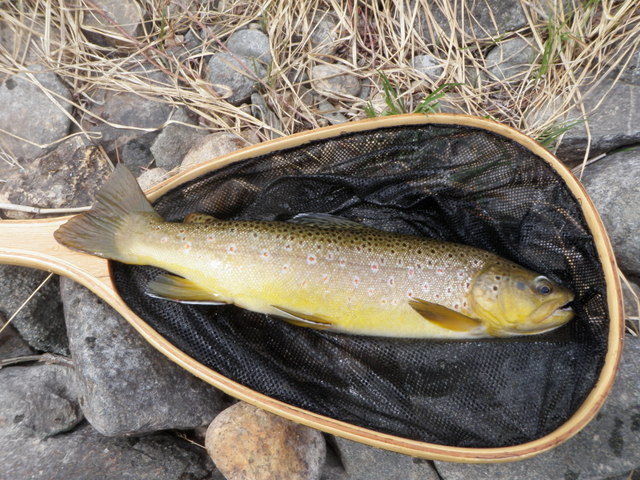
Best Fish of the Day Took Caddis Dry
I waded over to the bank and photographed my prize brown and then returned to my spot in the deeper water. Somehow my flies got tangled in the net and my line was wrapped around the net, but in the process of clearing everything for another cast, I twisted my weight and my pivot food slipped on a slimy rock, and all of a sudden Dave was doing the breast stroke and trying to stand up again. Water gushed over my frontpack and the front of my waders and as I stood I could feel ice water running down my legs and saturating my long underwear and socks. What should I do now? I had a change of clothes in the car, but fish were rising under the overcast sky. Even if I changed into dry clothes I would not be able to dry out the inside of my waders quickly, so I’d be damp and wet again. I decided to suck it up and continued fishing.
I sprayed some casts across and downstream to some rises and landed two more medium sized fish on the caddis. Alas the large clouds passed and the sun came back out and the wind calmed a bit and the caddis were no longer tumbling on the water. As you might expect the fish stopped rising. I sloshed my way back to the bank and climbed up to the railroad tracks and debated calling it a day. It was 3:15 and I decided it was too early to quit without going back to wet flies. Besides the water in my boots was warming up to my body temperature, and I was now operating in a large wet suit. I hiked up the railroad tracks until I reached another nice stretch of the river that I enjoy fishing. The character of the river here is similar to the wide riffles and fan shaped pockets I’d fished right after lunch.
I returned to nymphs but this time tied on a duke nymph (my streamlined version of a prince nymph) and below that a beadhead bright green caddis. I worked my way up through the long pockets and riffles over the next 45 minutes and landed two more nice fish, one a rainbow and the other a brown. The rainbow attacked the duke nymph as I stripped it back toward me after the end of the drift. The brown hit the duke at the very tail of the drift when the fly began to swing. By 4 o’clock I began to feel a bit chilled from being wet and I’d landed 22 trout so I decided to quit and start the long drive back to Denver. I made the long slosh back to the crossing point, carefully crossed to the south bank and exchanged my wet clothes for dry.
I’d broken the tip on my favorite rod, fallen in the river, and never saw a significant caddis emergence but had still managed to land 22 larger than average fish. More than anything I was impressed with the size of the fish I was catching in this stretch of the Arkansas River. I also rediscovered how much I enjoy dry/dropper fishing in the right circumstances. The visual experience isn’t quite as addictive as a fish rising to take a dry, but seeing the top fly dip and then setting the hook and feeling the strong weight of a nice fish is a close second. This describes much of the action in the morning on the north channel as fish took the tiny RS2.
Was my day epic? Probably not but certainly spectacular. Will I return to the Arkansas River again before snowmelt? One never knows.
Like this:
Like Loading...










